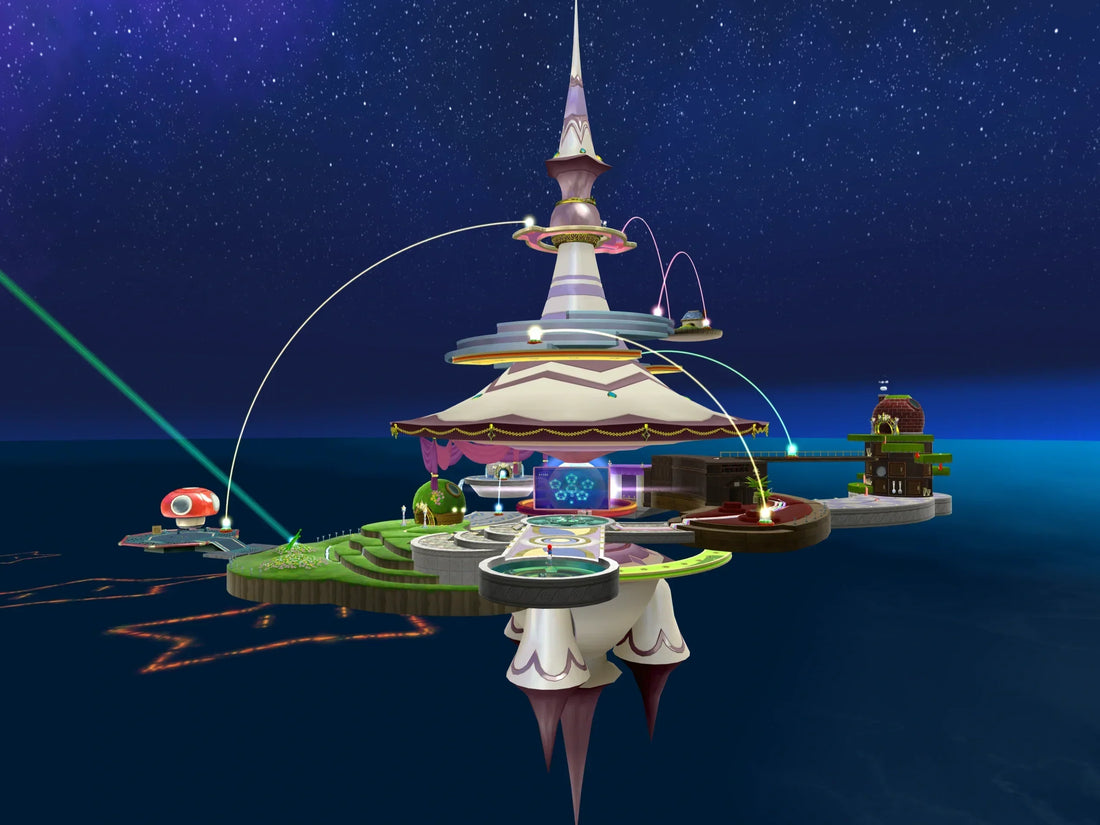
The Story of the Comet Observatory in Super Mario Galaxy: Nintendo's Most Iconic Spaceship
Share
841 mots | Temps de lecture : 4 minute(s)
Of all the hubs in the series, the Comet Observatory in Super Mario Galaxy is arguably the most memorable. A giant space station, part fairytale castle, part high-tech spaceship, it serves as Mario's intergalactic base … and the perfect backdrop for a wall poster in your gaming room! Let's discover its history, symbolism, and legacy.
Summary
- 1. What is the Comet Observatory?
- 2. Tragic origins and the tale of Rosalina
- 3. The 100-year cosmic cycle
- 4. Architecture and features
- 5. Symbolism and Themes
- 6. Impact on the Mario saga
- 7. Soundtrack and Atmosphere
- 8. Secrets and hidden details
- 9. Heritage & Pop Culture
- 10. Summary table
- 11. FAQ
- 12. Conclusion
What is the Comet Observatory?
The Comet Observatory is a celestial station powered by the energy of Cosmic Stars . A true crossroads to the galaxies, it replaces the usual castle and offers a circular hub level that has become iconic.
Its hybrid design blends glass domes, Victorian towers and metal pontoons — an ideal set to recreate with Lego Mario !
Tragic Origins and the Tale of Rosalina
Rosalina and the Lumas
Harmony's (Rosalina's) book tells the story of how a young Earth girl built the station to help a lost Luma find his mother star. Becoming inseparable, they piece together the comet to travel among the constellations.
The 100-year cosmic cycle
Every 100 years, the station soars across the Mushroom Kingdom during the Star Festival. Bowser steals it and the Grand Stars, setting off Mario's cosmic adventure.
Architecture and features
The main domes
- Terrace – Tutorial and Classic Galaxies
- Fountain – aquatic worlds
- Cuisine – gourmet planets
- Room – Night Galaxies
- Engine – mechanical universe
- Gate – Road to Bowser
In the center, the engine room concentrates stellar energy and acts as the heart of the ship.
Symbolism and Themes
The Comet explores the notions of motherhood (Rosalina protects her Lumas), the life cycle , and cosmic rebirth . Each Luma eventually becomes a planet, star, or galaxy, underscoring the theme of renewal.
Impact on the Mario saga
The first circular 3D "living" hub, it influenced Super Mario Galaxy 2 's Mario Ship and later hub-level concepts. To understand this connection, compare it to the pioneering castle in Super Mario 64 .
Soundtrack and atmosphere
The track "Rosalina in the Observatory" blends strings, harp, and piano to create an atmosphere that's both nostalgic and celestial. Sounds of comets, stellar winds, and mechanical beeps punctuate the exploration.
Secrets and hidden details
- A telescope points to a bonus galaxy containing a green Luma.
- Portraits of Rosalina's family decorate the Story Room .
- A retractable Luma night light illuminates a hidden hallway.
Heritage & Pop Culture
The station has become a symbol of the Wii era. Luma plushies, Rosalina plushies , Lego sets and vinyl OSTs celebrate its dreamlike aesthetic.
Summary table
| Dome | Theme | Galaxies | Key note |
|---|---|---|---|
| Terrace | Classic | 5 | Starting point |
| Fountain | Aquatic | 5 | Water Planets & Bubbles |
| Kitchen | Gourmand | 5 | Cake Planets |
| Bedroom | Nocturne | 5 | Dark galaxies |
| Engine | Mechanical | 5 | Giant gears |
| Door | Final | 1 | Battle against Bowser |
FAQ
- Is the Comet Observatory a real planet? No: it's an artificial ship powered by the Grand Stars.
- How many domes does it house? Six, each leading to 5 galaxies (except the Gate).
- Will we ever see Galaxy 3? Nintendo hasn't announced anything, but the community is calling for it.
- Is Rosalina related to Peach? Popular theory, never confirmed.
- Can you visit the comet in other games? Not entirely, but homages appear in 3D World or Mario Kart .
Conclusion
The Comet Observatory embodies the perfect blend of emotional storytelling , revolutionary level design , and magical aesthetics . A symbol of a bold Nintendo, it continues to shine in players' memories and fuels dreams of a future return to the stars.
For more cosmic stories, explore our Galaxy category or grab a Luma figurine to keep a piece of the star close to you.
